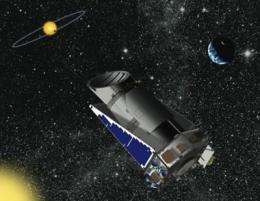Second rocky world makes Kepler-10 a multi-planet system

The Kepler Telescope team has announced a second planet orbiting the star Kepler-10. The existence of this planet was suspected previously, but new analytical techniques were needed to confirm its existence.
The Kepler Telescope team has found a new rocky planet, one they describe as a “scorched, molten Earth.”
The planet is about 2 times the size of Earth, and is very close to the Sun-like star Kepler-10, completing an orbit in only 45 days. Being so close to its sun, the blazing-hot new planet is not expected to have any liquid water or life as we know it.
The star Kepler-10 is located 564 light-years away, in the Draco constellation (although it is not bright enough to be seen with the naked eye).
Named Kepler-10c, the new planet’s existence was suspected when the Kepler team announced earlier this year that they’d found Kepler-10 b, a terrestrial planet orbiting the same star. However, the data was not conclusive enough for scientists to feel certain that what they were seeing was due to a planet.
A new technique was required to rule out other possibilities. The Kepler telescope looks at dips in starlight when a planet passes in front of a star from our point of view -- an event called a planetary transit. But other objects, such as stars, can also pass in front of the observed star and block the light.
To be sure the transit was not caused by eclipsing stars, the Kepler team combined a new computer simulation technique called “Blender” with infrared data from NASA’s Spitzer Space Telescope.
Blender is light-curve fitting software that allows the scientists to rule out other possible causes of the dip in starlight. When astronomers are observing a star, the total light emitted by the star over time can be represented as a relatively flat line. A short-lived dip in this line, called a light curve, indicates some of the light has been blocked briefly.
“We try to exhaustively look at all the things that could cause a light curve,” said Francois Fressin of the Harvard-Smithsonian Center for Astrophysics and a member of the Kepler team.
Blender results show that only a very small fraction of other objects can reproduce the exact same kind of light-curve as a planet. This helps give the scientists confidence that the light curve they are witnessing is due to the new planet Kepler-10c rather than something else.
Fressin said that the Blender method can be used to help the Kepler team figure out if any of the 1,235 candidates they have found so far are rocky planets like the Earth.
Bill Borucki, Kepler’s principal investigator, said hundreds more planet candidates are expected to be found before the end of the three-year mission. However, he noted that the Kepler team won’t release more data sets until June 2012 because they need more time to observe the stars and rule out other explanations for the changes in starlight.
Kepler’s main goal is to discover how common are Earths in habitable zones around Sun-like stars. Whether they are rare or common, once such worlds are located, astronomers can try to study them in order to learn whether they have alien life.
Source: Astrobio.net



















